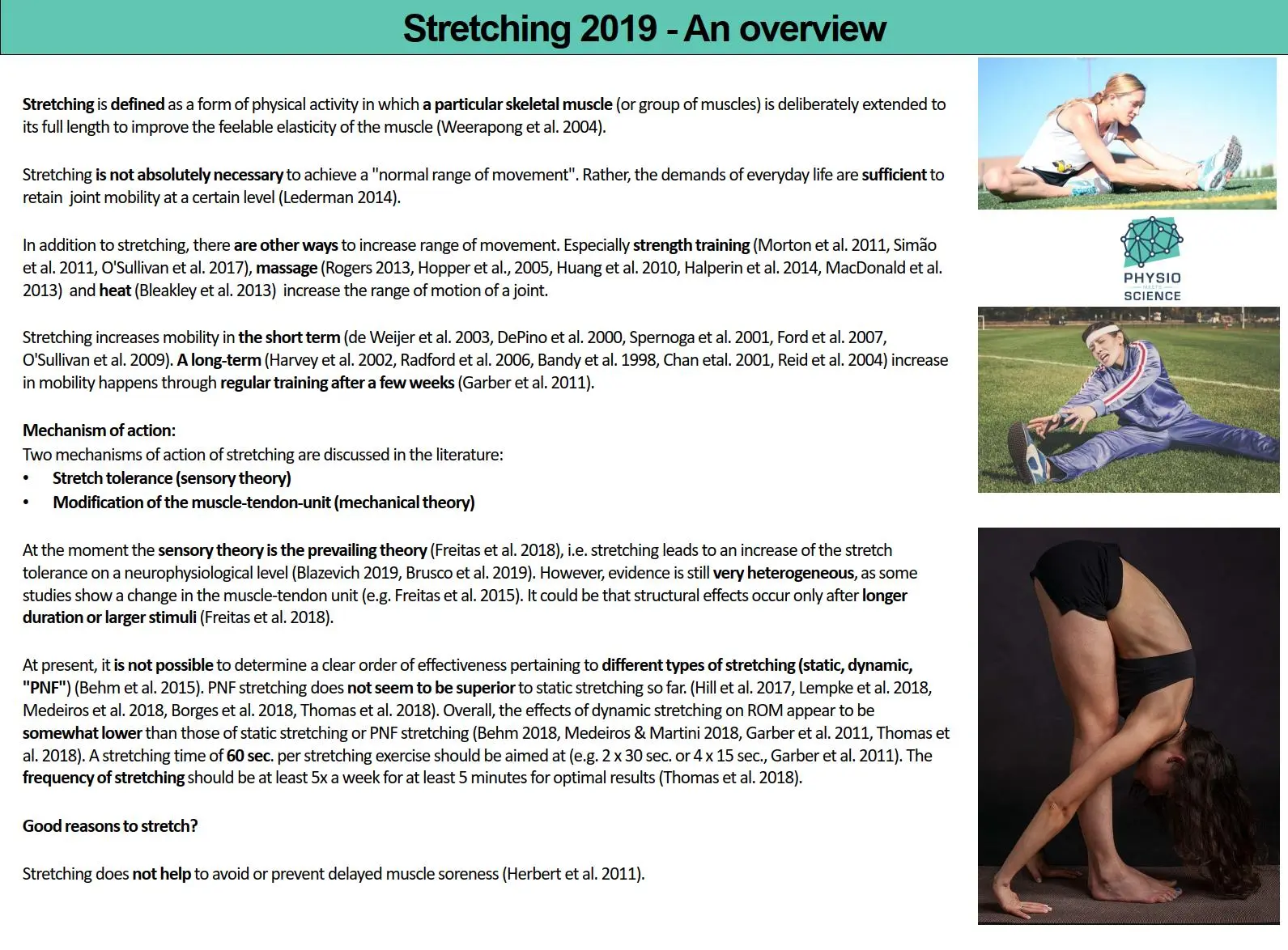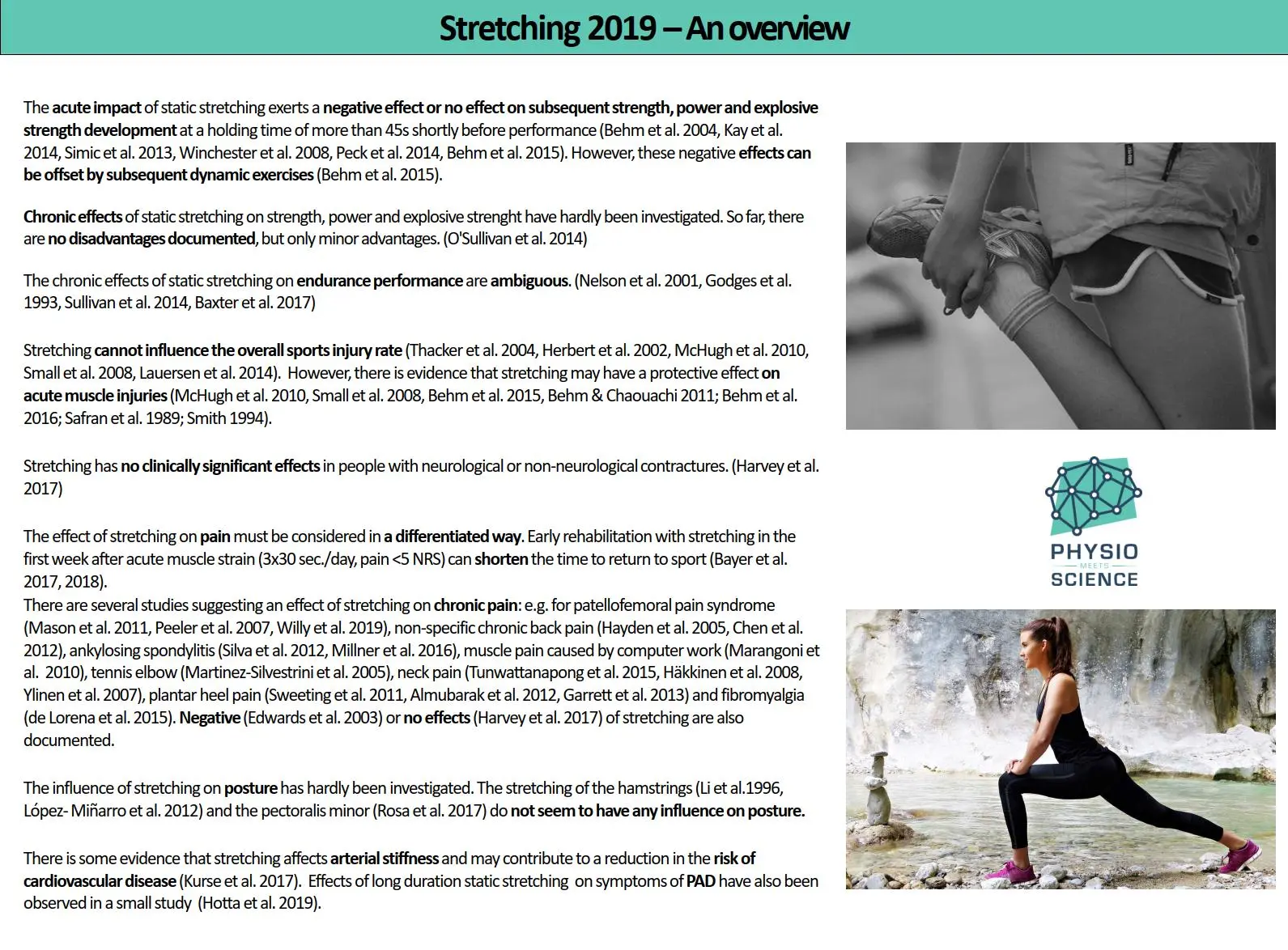
Physio meets scienceさんがXでストレッチの2019年時点での情報をまとめて下さったので、引用と和訳をします。
※掲載と和訳の許可は事前に得ています。
ツイートはこちらです。
Stretching 2019 - an overview
— Physio Meets Science (@PhysioMeScience) October 8, 2019
☝️👇👇👇 pic.twitter.com/k8Gbs68Hpq
目次
ストレッチとは?
以下、青緑色は引用、黒は私の考えとして掲載します。
ストレッチは特定の骨格筋(または筋群)を意図的に完全な長さまで伸ばし、筋の弾力感(feelable elasticity)を改善する身体活動の一形態と定義されます。
Stretching is defined as a form of physical activity in whicha particular skeletal muscle (or group of muscles)is deliberately extended to its full length to improve the feelable elasticity of the musdle (Weerapong et al. 2004).
ストレッチの効果性を筋の弾性(elasticity)やスティッフネス(stiffness)ではなく、弾力感(feelable elasticity)としているのは、可動域が解剖学的な要因により制限されているのではなく、感覚的な問題、いわゆるストレッチトレランスモデルで制限されていることを表しているようにみえます。
また似た表現としてFeeling stiffnessが用いられることがありますが、ここでの使用上の区別は不明です。
ここでは伸ばす対象を骨格筋(または筋群)と限定しています。ストレッチは歴史的に筋を伸張する目的で作られました。とはいえ最近ではストレッチの使用用途が拡大し、筋以外にも使用されていることは知っておく必要があります。
ストレッチは可動域を正常化するのに適している?
「正常な可動域(ROM:range of movement)」を達成するためにストレッチは絶対に必要というわけではありません。むしろ、日常生活を求めることは関節の可動性を一定のレベルで維持するのに十分です。
Stretching is not absolutely necessary to achieve a "normal range of movement". Rather,the demands of everyday life are sufficient to retain joint mobility at a certain level (Lederman 2014).
可動域の向上=ストレッチという認識が強いですが本来ストレッチは必ずしも必要なわけではないはずです。
例えば五十肩で大きく可動域が制限されている人は、ストレッチせずとも五十肩が治っていく過程で元の可動域に戻っていきます。
このような可動域を制限する疾患に限らず、日常生活で動いていれば可動域は必要なレベルを保ちます。
リハビリの過程で可動域を維持、向上させることで再発の予防ができるケースではストレッチは有用かもしれません。
このように、人によって正常な可動域を達成するためにストレッチが使えるケースとそうでないケースがあるだけです。
可動域を上げる方法
ストレッチ以外にも、可動域を広げる方法があります。特に筋力トレーニングやマッサージ、温熱刺激は関節の可動域を広げます。
In addition to stretching,there are other ways to increase range of movement. Especially strength training (Morton et al. 2011,Simão et al. 2011,O'Sullivan et al. 2017),massage (Rogers 2013,Hopper et al,2005,Huang et al. 2010,Halperin et al. 2014,MacDonald et al. 2013)and heat (Bleakley et al. 2013)increase the range of motion of a joint.
ストレッチは短期的に可動性を高めます。
長期的な可動性の向上は、数週間にわたる定期的なトレーニングによってもたらされます。
Stretching increases mobility in the short term (de Weijer et al. 2003,DePino et al. 2000,Spernoga et al. 2001,Ford et al. 2007,O'Sullivan et al. 2009). A long-term (Harvey et al. 2002,Radford et al. 2006,Bandy et al. 1998,Chan etal. 2001,Reid et al. 2004)increase in mobility happens through regular training after a few weeks (Garber et al. 2011).
特に筋トレによって可動域が上昇することを知らないだけでなく、むしろ筋が短縮すると考えている人もいます。
単に組織を伸ばすのではなく、動くこと自体が可動域の維持や向上に寄与する認識が必要なのかも知れません。
ストレッチのメカニズム(作用機序)
作用機序:ストレッチングの2つの作用機序が文献で考察されています。
・ストレッチトレランス(感覚理論)
・筋腱ユニットの変化(機械論)
Mechanism of action: Two mechanisms of action of stretching are discussed in the literature:
・Stretch tolerance (sensory theory)
・Modification of the muscle-tendon-unit (mechanical theory)
※ストレッチトレランスはストレッチによる痛みや不快感の耐性を意味しており、ストレッチにより可動域が向上するメカニズムはストレッチによる痛みや不快感を許容できるようになったからという理論です。
現時点では感覚理論が有力であり、ストレッチは神経生理学的レベルでのストレッチトレランスの増加につながります。しかし、筋腱単位の変化を示す研究もあるため、エビデンスは依然として非常に異質性があります。構造的な影響は、より長い期間またはより大きな刺激の後にのみ生じる可能性があります。
At the moment the sensory theory is the prevailing theory (Freitas et al. 2018),i.e. stretching leads to an increase of the stretch tolerance on a neurophysiological level (Blazevich 2019,Brusco et al. 2019). However,evidence is still very heterogeneous,as some studies show a change in the muscle-tendon unit (e.g. Freitas et al. 2015). It could be that structural effects occur only after longer duration or larger stimuli (Freitas et al. 2018)
ストレッチ種類による効果の違いとストレッチの時間
現在のところ、さまざまな種類のストレッチ(静的、動的、PNF)の効果について、明確な順序を決めることはできません。
PNFストレッチングが静的ストレッチングより優れているようには今のところ思われません。
全体的に、動的ストレッチングのROMに対する効果は、静的ストレッチングやPNFストレッチングよりもやや低いようです。
1回のストレッチ時間は60秒を目安にします(例:30秒×2回、15秒×4回)。
最適な結果を得るためには、ストレッチングの頻度は少なくとも週に5回、5分以上行うべきです。At present,it is not possible to determine a clear order of effectiveness pertaining to different types of stretching (static,dynamic,"PNF")(Behm et al. 2015). PNF stretching does not seem to be superior to static stretching so far. (Hill et al. 2017,Lempke et al. 2018,Medeiros et al. 2018,Borges et al. 2018,Thomas et al. 2018). Overall,the effects of dynamic stretching on ROM appear to be somewhat lower than those of static stretching or PNF stretching (Behm 2018,Medeiros & Martini 2018,Garber et al. 2011,Thomas et al. 2018). A stretching time of 60 sec. per stretching exercise should be aimed at (e.g. 2 x 30 sec. or 4x 15 sec,Garber et al. 2011). The frequency of stretching should be at least 5x a week for at least 5 minutes for optimal results (Thomas et al. 2018).
ストレッチを行う必要はありますか?
ストレッチをする理由はありますか?Good reasons to stretch?
ストレッチは筋肉痛の予防や回避に役立ちません。Stretching does not help to avoid or prevent delayed muscle soreness (Herbert et al. 2011)
静的ストレッチの短期的な影響は、パフォーマンスの直前の45秒以上の保持でその後の強度、パワー、爆発力の発達に負の影響を与えるか、影響しません。しかし、これらの悪影響は、その後のダイナミックエクササイズで相殺できます。The acute impact of static stretching exerts a negative effect or no effect on subsequent strength,power and explosive strength development at a holding time of more than 45s shortly before performance (Behm et al. 2004,Kay et al. 2014,Simic et al. 2013,Winchester et al. 2008,Peck et al. 2014,Behm et al. 2015). However,these negative effects can be offset by subsequent dynamic exercises (Behm et al. 2015).
長期的なストレッチの影響
静的ストレッチングが強度、パワー及び爆発力に及ぼす慢性的な影響はほとんど研究されていません。これまでのところ、欠点は記載されていませんが、小さな利点しかありません。Chronic effects of static stretching on strength,power and explosive strenght have hardly been investigated. So far,there are no disadvantages documented,but only minor advantages. (O'Sullivan et al. 2014)
持続力のパフォーマンスに対する慢性的なストレッチの影響は曖昧です。The chronic effects of static stretching on endurance performance are ambiguous. (Nelson et al. 2001,Godges et al. 1993,Sullivan et al. 2014,Baxter et al. 2017)
ストレッチの怪我予防効果
ストレッチは全体的なスポーツ傷害率に影響しません。
しかしながらストレッチングが急性筋損傷に対して保護する効果を持つかもしれないという証拠があります。Stretching cannot influence the overall sports injury rate (Thacker et al. 2004,Herbert et al. 2002,McHugh et al. 2010,Small et al. 2008,Lauersen et al. 2014). However,there is evidence that stretching may have a protective effect on acute muscle injuries (McHugh et al. 2010,Small et al. 2008,Behm et al. 2015,Behm & Chaouachi 2011;Behm et al. 2016;Safran et al. 1989;Smith 1994).
拘縮に対するストレッチの効果
ストレッチングは、神経学的または非神経学的拘縮を有するヒトでは臨床的に重要な効果はありません。Stretching has no clinically significant effects in people with neurological or non-neurological contractures. (Harvey et al. 2017)
これまでストレッチの効果は健常者を対象に行われているケースが多く、その結果が拘縮に対するアプローチの根拠としてましたが、残念ながら拘縮には効果がありませんでした。
痛みに対するストレッチの効果
痛みに対するストレッチの効果は、区別して考える必要があります。急性筋損傷後の最初の週におけるストレッチングによる早期リハビリテーションは、スポーツへの復帰時間を短縮できます。いくつかの研究はストレッチの慢性疼痛への効果を示唆しています。例えば、膝蓋大腿部痛、非特異的慢性背部痛、強直性脊椎炎、コンピュータ作業による筋痛、テニス肘、頚部痛、足底の踵骨痛、線維筋痛症があります。またストレッチの負の効果、または効果なしも報告されています。The effect of stretching on pain must be considered in a differentiated way. Early rehabilitation with stretching in the first week after acute muscle strain (3x30 sec./day,painSNRS)can shorten the time to return to sport (Bayer et al. 2017,2018)There are several studies suggesting an effect of stretching on chronic pain: e.g. for patellofemoral pain syndrome (Mason et al. 2011,Peeler et al. 2007,Willy et al. 2019),non-specific chronic back pain (Hayden et al. 2005,Chen et al. 2012),ankylosing spondylitis (Silva et al. 2012,Millner et al. 2016),muscle pain caused by computer work (Marangoni et al. 2010),tennis elbow (Martinez-Silvestrini et al. 2005),neck pain (Tunwattanapong et al. 2015,Häkkinen et al. 2008,Ylinen et al. 2007),plantar heel pain (Sweeting et al. 2011,Almubarak et al. 2012,Garrett et al. 2013)and fibromyalgia (de Lorena et al. 2015). Negative (Edwards et al. 2003)or no effects (Harvey et al. 2017)of stretching are also documented.
ストレッチは姿勢を変えられるか?
ストレッチの姿勢に関する研究はほとんどされていません。ハムストリングや小胸筋のストレッチは姿勢に影響しません。The influence of stretching on posture has hardly been investigated. The stretching of the hamstrings (Li et al.1996,López- Miñarro et al. 2012)and the pectoralis minor (Rosa et al. 2017)do not seem to have any influence on posture.
ストレッチのその他効果
ストレッチングが動脈硬化に影響を与え、心血管疾患のリスクの低下を与えるいくつかのエビデンスがあります。PAD症状に対する長時間の静的ストレッチングの影響も小規模の研究で観察されています。There is some evidence that stretching affects arterial stiffness and may contribute to a reduction in the risk of cardiovascular disease (Kurse et al. 2017). Effects of long duration static stretching on symptoms of PAD have also been observed in a small study (Hotta et al. 2019).








